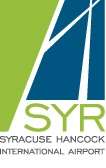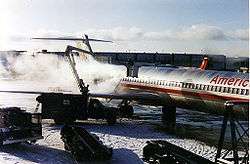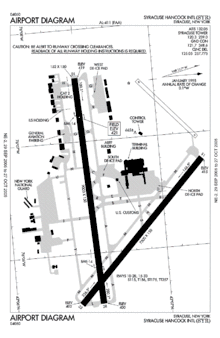Syracuse Hancock International Airport
| Syracuse Hancock International Airport | |||||||||||||||
|---|---|---|---|---|---|---|---|---|---|---|---|---|---|---|---|
 | |||||||||||||||
| Summary | |||||||||||||||
| Airport type | Public | ||||||||||||||
| Owner | Syracuse Regional Airport Authority | ||||||||||||||
| Operator | Syracuse Department of Aviation | ||||||||||||||
| Serves | Syracuse, New York, U.S. | ||||||||||||||
| Location | DeWitt / Salina / Cicero, Onondaga County, New York | ||||||||||||||
| Elevation AMSL | 421 ft / 128 m | ||||||||||||||
| Coordinates | 43°06′40″N 076°06′23″W / 43.11111°N 76.10639°WCoordinates: 43°06′40″N 076°06′23″W / 43.11111°N 76.10639°W | ||||||||||||||
| Website | flysyracuse.com | ||||||||||||||
| Map | |||||||||||||||
 SYR Location of airport in New York / United States  SYR SYR (the US) | |||||||||||||||
| Runways | |||||||||||||||
| |||||||||||||||
| Statistics (2011, 2018) | |||||||||||||||
| |||||||||||||||
Syracuse Hancock International Airport (IATA: SYR, ICAO: KSYR, FAA LID: SYR) is a joint civil-military airport five miles northeast of downtown Syracuse, in Onondaga County, New York, United States.[1] The airport is off Interstate 81 near Mattydale, New York. The main terminal complex is at the east end of Colonel Eileen Collins Boulevard.
The National Plan of Integrated Airport Systems for 2011–2015 called it a primary commercial service airport.[3] Federal Aviation Administration records say the airport had 1,105,143 passenger boardings (enplanements) in calendar year 2008,[4] 1,016,571 in 2009 and 1,024,505 in 2010.[5]
History
In 1927 Syracuse mayor Charles Hanna felt his city needed an airport. A location at Amboy in the town of Camillus, New York was purchased for $50,000, and by 1928, the "Syracuse City Airport at Amboy" was handling airmail. At the end of World War II the United States Army Air Corps leased their bomber base near Mattydale, New York to the city. On September 17, 1949 the Clarence E. Hancock Airport opened to the public using a renovated machine shop as a terminal, and replaced the airport at Amboy. The airport had three concrete runways, 5,500 feet (1,700 m) long and 300 feet (91 m) wide. American, Buffalo, Colonial and Robinson Airlines were the first airlines at the airport. By the mid-1970s, the airport was dominated by Allegheny Airlines, with some competition from Eastern and American.[6]
Utica-based Empire Airlines emerged as a regional competitor to Allegheny's successor USAir by the early 1980s.[7][8] Empire planned to move its headquarters to Syracuse, but these plans were cancelled when Piedmont Airlines acquired Empire in 1986.[9] After a legal battle with the city, Piedmont agreed to maintain a hub operation at the airport and advance funds for construction of a new terminal concourse.[10] USAir acquired Piedmont in 1989, becoming the airport's dominant carrier, but dismantled the Syracuse hub during the 1990s, leading to the closure of several gates in the terminal.[11]

In 2004 Syracuse Mayor Matthew Driscoll created a television and internet campaign, Fly Syracuse,[12] hoping to lower fares and increase passenger traffic at the airport. The airport has since experienced growth thanks to the efforts of local business contributions toward the campaign.
The biggest aircraft to ever visit Syracuse was on July 9, 2016 and was a charter flight operated by a United Airlines Boeing 747-400. On June 19, 2017 a Delta Airlines A330-300 flying from LAX-JFK was diverted to Syracuse because of weather on the east coast.
Facilities
The airport covers 2,000 acres (809 ha) at an elevation of 421 feet (128 m). It has two asphalt runways: 10/28 is 9,003 by 150 feet (2,744 × 46 m) and 15/33 is 7,500 by 150 feet (2,286 × 46 m).[1]
The east–west instrument runway (10-28) was extended from its original 5,500 feet by the mid-1950s to 6,863 feet and a few years later to 8,000 feet. In 1958 the instrument landing system to runway 28 was augmented with a 3,000-foot high-intensity-approach lighting system. With the use of the Century series fighter aircraft by the Air Force, around 1960 the main east–west runway was extended again, to 9,003 feet. The runway was strengthened in the early 1960s for the heavier Boeing 707. In the 1960s runway centerline lighting was added to the main runway and touchdown zone lighting on the runway 28 end.
Around the time of building the new terminal building, runway 6-24 was shortened to 3,261 feet (to make room for the entrance road to the new terminal) and continued to be a general aviation runway into the 1970s, and was abandoned after that. Runway 14-32 was lengthened in the 1960s to 6,000 feet. Another extension brought it to 6,480 feet and sometime around 1980 to its present length of 7,500 feet. The crosswind runway was renumbered from 14-32 to 15-33. An instrument landing system was added to runway 10 with medium-intensity-approach lighting with runway alignment indicator lights. Runway 15 got a medium-intensity-approach lighting system.[13]
In the year ending September 30, 2011 the airport had 72,113 aircraft operations, average 197 per day: 45% air taxi, 24% airline, 20% military, and 12% general aviation. 93 aircraft were then based at this airport: 55% single-engine, 26% military, 10% multi-engine, 8% jet, and 2% helicopter.[1]
Operations


Syracuse receives an average 124 inches (3,100 mm) of snow annually, most of any major city in the United States. On average, the airport is closed less than 24 hours annually due to snowfall. The airport has received the Balchen/Post Award for Excellence in the Performance of Snow and Ice Control eight times, most recently in 2012-2013.[14] Runway 28 allows for Category II instrument landing system (ILS).
Expansion and growth
C&S is providing professional design and construction inspection/observation services for the construction of the Syracuse Hancock International Airport terminal security and access improvement project, a 147,000-square-foot (13,700 m2) renovation design project with an estimated cost of $63 million. The most critical components of the project include: post check-in TSA baggage handling, improved passenger screening, and sustainability. This project is 100 percent funded by PFC's (Passenger Facility Charges) meaning that no tax dollars will be used to construct this project. For more information refer to www.flysyracuse.com.[15] This project connects Terminal A to Terminal B. This allows all passengers to be screened at a centralized location, and then proceed to their gate from the center. There will also be new concessions and restaurants housed in the new area, as well as in the existing areas of Terminals A and B. This will hopefully create greater appeal for new airlines to fly into Syracuse. On May 15, 2013, the airport opened the new security area to passengers. As expected with anything new, there were some minor glitches; 40 passengers missed flights. They were reimbursed by the airport with $150 vouchers. On day 2, the airport processed 881 passengers through the new security checkpoint, and had zero problems. Before the new gate that houses the security checkpoint is an observatory for children to watch planes.[16]
Delaware North held the contract for the airport's terminal and concourse food options until October 11, 2013, when the airport authority awarded a fifteen-year contract to New York's Creative Food Group LLC; under Delaware North the airport's dining options had been criticized for not keeping up with the times and the dining area feeling more like a 'mall food court', as the airport previously had outlets like Sbarro and brands unknown to travelers like Dinosaur BBQ.[17] Creative plans (and currently has temporary kiosks open for) to add Dunkin' Donuts and Jamba Juice during the airport's modernization, along with a Johnny Rockets, and CNBC and New York Times-branded newsstands and bookstores operated by The Paradies Shops. The Saranac Pub, along with another bar based on the products of the local Middle Ages Brewing Company, will also be planned as part of the modernization, which should be completed by Thanksgiving 2014.[18]
On December 12, 2013 Senator Charles Schumer (D-New York) announced that he had met with Delta CEO Richard Anderson. The purpose was to bring in new air service, and Schumer was successful. Delta's service to JFK from Hancock will be tripled from one daily trip to three daily trips beginning April 2014. In addition, extra flights to Minneapolis will be added, although the number was unspecified. Service to Atlanta will be served by larger aircraft, which will lead to an 8% seat capacity jump.
Airlines and destinations
Passenger
| Airlines | Destinations | Refs |
|---|---|---|
| Air Canada Express | Toronto–Pearson (ends November 1, 2018)[19] | [20] |
| Allegiant Air | Fort Lauderdale, Orlando/Sanford, St. Petersburg/Clearwater Seasonal: Myrtle Beach, Nashville, Punta Gorda (begins November 15, 2018) | [21][22] |
| American Airlines | Boston, Charlotte, Chicago–O'Hare, Philadelphia, Washington–National | [23] |
| Delta Air Lines | Atlanta, Detroit, Minneapolis/St. Paul, New York–JFK, New York–LaGuardia | [24] |
| Frontier Airlines | Orlando Seasonal: Chicago–O'Hare, Denver, Fort Myers (begins November 15, 2018)[25], Raleigh/Durham, Tampa (begins November 15, 2018)[26] | [27] |
| JetBlue Airways | Boston, New York–JFK, Orlando Seasonal: Fort Lauderdale (resumes December 20, 2018) | [28] |
| United Airlines | Chicago–O'Hare, Newark, Washington–Dulles | [29] |
Cargo
| Airlines | Destinations |
|---|---|
| FedEx Express | Burlington (VT), Harrisburg, Indianapolis, Memphis |
| FedEx Feeder | Newark |
| UPS Airlines | Albany, Buffalo, Hartford/Springfield, Louisville, Philadelphia, Roanoke Seasonal: Manchester (NH) |
Statistics
Top destinations
| Rank | City | Passengers | Carriers |
|---|---|---|---|
| 1 | Chicago–O'Hare, Illinois | 175,120 | American, United |
| 2 | Atlanta, Georgia | 136,450 | Delta |
| 3 | New York–JFK, New York | 115,430 | Delta, JetBlue |
| 4 | Charlotte, North Carolina | 111,250 | American |
| 5 | Philadelphia, Pennsylvania | 77,760 | American |
| 6 | Detroit, Michigan | 69,850 | Delta |
| 7 | Washington–National, D.C. | 57,900 | American |
| 8 | Newark, New Jersey | 56,380 | United |
| 9 | New York–LaGuardia, New York | 55,150 | Delta |
| 10 | Washington–Dulles, D.C. | 43,200 | United |
Annual traffic
| Year | Passengers | Year | Passengers |
|---|---|---|---|
| 2010 | 1,035,916 | ||
| 2009 | 1,024,227 | ||
| 2008 | 1,116,584 | ||
| 2017 | 1,036,570 | 2007 | 1,184,162 |
| 2016 | 999,158 | 2006 | 1,133,040 |
| 2015 | 1,000,722 | 2005 | 1,228,991 |
| 2014 | 998,900 | 2004 | 1,135,713 |
| 2013 | 1,000,466 | 2003 | 954,930 |
| 2012 | 988,347 | 2002 | 953,935 |
| 2011 | 999,880 | 2001 | 953,011 |
Flight schools
Syracuse Hancock International is home to Syracuse Flight School which replaced what was Waypoint Flight School.
See also
References
- 1 2 3 4 FAA Airport Master Record for SYR (Form 5010 PDF). Federal Aviation Administration. effective November 15, 2012.
- ↑ 2010 North American final rankings Archived May 24, 2011, at the Wayback Machine.
- ↑
"2011–2015 NPIAS Report, Appendix A" (PDF, 2.03 MB). National Plan of Integrated Airport Systems. Federal Aviation Administration. October 4, 2010. External link in
|work=(help) - ↑
"Enplanements for CY 2008" (PDF, 1.0 MB). CY 2008 Passenger Boarding and All-Cargo Data. Federal Aviation Administration. December 18, 2009. External link in
|work=(help) - ↑
"Enplanements for CY 2010" (PDF, 189 KB). CY 2010 Passenger Boarding and All-Cargo Data. Federal Aviation Administration. October 4, 2011. External link in
|work=(help) - ↑ "SYR75p1". www.departedflights.com. Retrieved 2018-10-03.
- ↑ "SYRintro". www.departedflights.com. Retrieved 2018-10-03.
- ↑ "SYR85intro". www.departedflights.com. Retrieved 2018-10-03.
- ↑ "DECONTROL AIDED EMPIRE AIR". Retrieved 2018-10-03.
- ↑ "Piedmont, Syracuse sign agreement". UPI. Retrieved 2018-10-03.
- ↑ "Syracuse Hancock Intl Airport". www.airports-worldwide.com. Retrieved 2018-10-03.
- ↑ "FlySyracuse.com". Archived from the original on February 4, 2012. Retrieved January 9, 2012.
- ↑ "KSYR - Syracuse Hancock International Airport". AirNav. Retrieved 2013-08-28.
- ↑ "North East Chapter American Association of Airport Executives - The Balchen/Post Award". Necaaae.org. 2013-04-24. Retrieved 2013-08-28.
- ↑ https://web.archive.org/web/20120419095338/http://www.syrairport.org/about/projects/termsec.cfm. Archived from the original on April 19, 2012. Retrieved February 4, 2016. Missing or empty
|title=(help) - ↑ Dick Blume (2013-05-16). "Day Two: No delays at Syracuse airport security". syracuse.com. Retrieved 2013-08-28.
- ↑ "Out With Sbarro and In With 'Dinosaur BBQ' at Syracuse Airport". Jaunted. 11 July 2011. Retrieved 3 July 2014.
- ↑ "By changing dining choices, Hancock Airport officials hope to influence ticket prices". WSYR-TV. 2 June 2014. Retrieved 3 July 2014.
- ↑ https://www.flightglobal.com/news/articles/air-canada-to-drop-three-us-cities-452386/
- ↑ "Flight Schedules". Retrieved 7 January 2017.
- ↑ "Allegiant Air". Retrieved 7 January 2017.
- ↑ "Allegiant Air".
- ↑ "Flight schedules and notifications". Retrieved 7 January 2017.
- ↑ "FLIGHT SCHEDULES". Retrieved 7 January 2017.
- ↑ "Frontier adds Las Vegas, Phoenix and four other cities for SW Florida International". 8 August 2018.
- ↑ "Frontier announces six more routes from Tampa International Airport". 8 August 2018.
- ↑ "Frontier". Retrieved 4 April 2018.
- ↑ "JetBlue Airlines Timetable". Retrieved 29 January 2017.
- ↑ "Timetable". Retrieved 7 January 2017.
- ↑ "RITA | BTS | Transtats". Transtats.bts.gov. Retrieved November 27, 2012.
- ↑ "Passenger Traffic - Syracuse Hancock International Airport".
External links
| Wikimedia Commons has media related to Syracuse Hancock Airport. |
- Official website
- LiveATC's Streaming Audio of SYR ATC
- Historical Photos of the original airport at Amboy, as well as its current state
- Syracuse Hancock International (SYR) from New York State DOT airport directory
- Aerial image as of March 1995 from USGS The National Map
- FAA Airport Diagram (PDF), effective October 11, 2018
- FAA Terminal Procedures for SYR, effective October 11, 2018
- Resources for this airport:
- AirNav airport information for KSYR
- ASN accident history for SYR
- FlightAware airport information and live flight tracker
- NOAA/NWS latest weather observations
- SkyVector aeronautical chart for KSYR
- FAA current SYR delay information